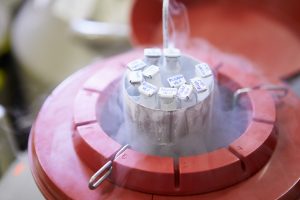$15 Million Verdict Against IVF Cryopreservation Tank Maker Is Big News
This verdict will seriously concern tank manufacturers and fertility clinics alike.
 In a shocking and terrible coincidence, on March 4, 2018, two cryopreservation storage tanks–half a country away from each other–failed on the same day. Numerous patients’ cryopreserved embryos and eggs — their hope for future children — were heated above safe storage temperatures, and irreparably damaged.
In a shocking and terrible coincidence, on March 4, 2018, two cryopreservation storage tanks–half a country away from each other–failed on the same day. Numerous patients’ cryopreserved embryos and eggs — their hope for future children — were heated above safe storage temperatures, and irreparably damaged.
One of those tanks was at University Hospital in Cleveland. The other was known as “Tank 4,” and was located at Pacific Fertility Center in San Francisco. Tank 4 contained 2,500 embryos and 1,500 eggs, and on that fateful day, literally imploded. (The plaintiffs even included the shocking images of the imploded tanks in their court pleadings.) Last week, three years after the incident, five of the victims received a jury award totaling $15 million in compensation for pain, suffering, and emotional distress against the tank manufacturer, Chart Inc.
The Math

Data Privacy And Security With Gen AI Models
Of the five plaintiffs in the case, two individuals were a couple that had four embryos in Tank 4. The other three plaintiffs were single women with eggs stored in Tank 4: two, nine, and 18 eggs, respectively. The couple were awarded $7 million in damages for pain and suffering, while the three individuals were awarded $2 million, $2.5 million, and $3 million.
Because I went to law school and not … math school, I did some very rudimentary calculations to try to figure out the total damages of the tank failure, if the jurors’ numbers applied across all eggs and embryos lost in Tank 4. Obviously every case is different, especially given the variability of emotional damages, but let’s just say: dividing the damages award by the number of eggs at issue, and multiplying it by the number of eggs in Tank 4, equals approximately $592 million. But that’s just the potential damage award for all of the eggs. Doing the same calculation for the embryos gives you the staggering result of $4.375 billion. Yeah. Billion. Meaning, if the defendants had to compensate all of the victims similarly to these plaintiffs, we are talking about some serious numbers, solidly in the $5 billion-plus range. This verdict will seriously concern tank manufacturers and fertility clinics alike.
A Tale Of Two (Or More) Defects
The plaintiffs’ trial brief, filed before the case went to the jury, lays out the cause — or multiple causes, really — for Tank 4’s failure. Testing showed that there was a crack in a weld on the inside of the tank, where the tube used to refill the liquid nitrogen was connected. Experts testified that the tank was manufactured incorrectly, using only a partial-penetration weld, while the design specifications called for a full-penetration weld. And, in fact, this same flaw caused tank implosions that had happened at least twice before with similar tanks storing bone marrow.
Sponsored

Data Privacy And Security With Gen AI Models

Legal Contract Review in Under 10 Minutes? Here’s How

Tackling Deposition Anxiety: How AI Is Changing The Way Lawyers Do Depositions

Legal Contract Review in Under 10 Minutes? Here’s How
The plaintiffs also successfully demonstrated to the jury that the tank had a design defect. The fitting used to join the fill tube to the inner vessel was not designed to sit flush against the inner vessel. The fitting is flat, but the vessel is curved. And experts testified that it would have been easy enough to manufacture a more fitting fitting.
But even if there was a crack, or other failure, shouldn’t there be some warning system that gives enough time to save the eggs or embryos?
That was the next issue — the backup alert system. Tank 4 used a “TEC 3000” electronic controller to monitor the tank’s conditions and sound alarms if the amount of liquid nitrogen dropped too low. Unfortunately, this part too had a known defect, frequently alarming even when a tank’s liquid nitrogen was full. Two weeks before the incident, the controller to Tank 4 was repeatedly giving false alarms and attempting to refill the already full tank. In order to stop the malfunction, the laboratory director unplugged the controller. *Oh no. Cue the ominous music.* Chart knew of this particular failure problem with the controllers, yet the company chose to keep quiet and not inform its customers.
Who’s To Blame?
Chart focused its defense on shifting blame away from itself and trying to place it on the fertility clinic for unplugging the warning system. The jury mostly disagreed, placing 90% of the blame on Chart, and only 10% on the fertility clinic. But the clinic shouldn’t breath too much of a sigh of relief. 10% of $15 million is still $1.5 million. And 10% of $5 billion is still … lots of money.
Sponsored

Curbing Client And Talent Loss With Productivity Tech

How Thomson Reuters Supercharged CoCounsel With Gen AI Advances

This News Is Big
I had a chance to check in with ART law expert Colleen Quinn. Quinn previously served as an expert witness on the valuation of eggs and embryos in the Ohio case. (Check out this podcast where we interview her about the fascinatingly difficult job of making such valuations.)
Quinn explained, “as a personal injury, products liability, and assisted reproductive technology attorney, the verdict shows just how a jury can empathize with these poor families who suffered a loss of future children and loss of future life simply due to a manufacturing defect.” Quinn explained that the manufacturer knew how critical it was to design a storage unit that was going to house precious and unreplaceable reproductive material, yet failed not only to design a proper storage tank but one that did not even have a reliable backup system. “The verdict sends a message to all manufacturers of cryopreservation units to ensure a fail-safe system.”
Will the plaintiffs ever see the money? That’s a whole other question. In the meantime, manufacturers should be triple-checking their designs and processes, and clinics should take heed that unplugging a malfunctioning warning system is a recipe for disaster … and serious liability.
 Ellen Trachman is the Managing Attorney of Trachman Law Center, LLC, a Denver-based law firm specializing in assisted reproductive technology law, and co-host of the podcast I Want To Put A Baby In You. You can reach her at [email protected].
Ellen Trachman is the Managing Attorney of Trachman Law Center, LLC, a Denver-based law firm specializing in assisted reproductive technology law, and co-host of the podcast I Want To Put A Baby In You. You can reach her at [email protected].







